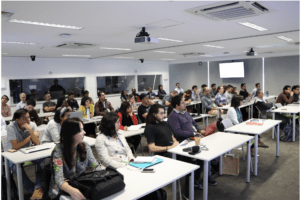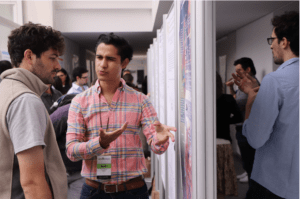The first session of the reverse vaccinology workshop began with a lecture from Debora de Oliveira-Lopes who explained the work-flow she utilises to identify epitopes for candidate for potential Schistosoma vaccines. She begins this process by selecting immunodominant epitopes that were identified by in-vitro antibodies (Ab) selection. She then reverse transcribes the amino-acid sequences to get the respective genomic sequence. The best epitopes were selected by performing alignment assays with known T and B cell Receptops (TCR, BCR) epitopes and evaluating their capacity of be recognized by HLA-DR molecules. The use of this technique is becoming frequently used in vaccines development as it reduces costs of conducting in vivo confirmatory experiments. Jesús Martinez Barnetche and Lenin Dominguez conducted a workshop focusing on identifying epitope and paratope interaction of the BCR and Abs that can be explored further using structural biology platforms and molecular docking.
On the third day, Alessandro Sette talked about curation and construction of the Immune Epitope Database (IEDB), and as well as an international collaborative project that applies integrative strategies for the study of infectious diseases, vaccine development and autoimmunity research. For the final lecture, Juan Carlos Almagro talked about the 3D modelling strategies for Abs engineering and the main properties considered during their evaluation before synthesis and transferring to clinical trials.
The three days of course included multiple practical sessions conducted by Jennifer Enciso, Antonio Del Río-Chanona, Jose Davila-Velderrain, Fernán Aguero, Lenin Domínguez and Ricardo Vázquez. During these practical sessions participants used R and Python programming, for Boolean modeling and, analysis and visualization of high-throuput data. Additionally, we had sessions on molecular docking that covered the in-situ simulation of ligand docking with a Toll-like receptor. Each practical session was complemented with information about available on-line tools including databases for crystal structures, on-line tools for the construction of protein-protein networks, epitope databases, among many others. During the course, participants also had the opportunity to present their research during posters sessions.
In the era of Immunoinformatics, new computational tools promise to reveal important information to explain multi-systemic interactions of immune system, nervous central system and even microbiome, influencing in complex emerging properties like circadian cycle. We are certain that in few years we would be able to model the complex dialogue between tumor cells and their microenvironment in cancer or to answer important questions related to, for instance, numerous clinical trials failure, which didn’t consider the heterogeneity of the immune system or microbiota in participants.
Article by Juan Carlos Balandrán & Jennifer Enciso













